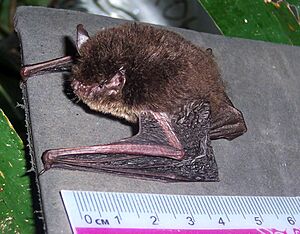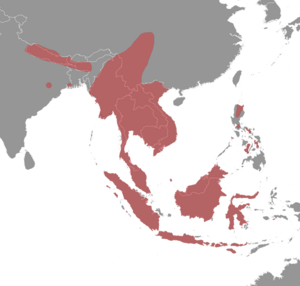Wall-roosting mouse-eared bat facts for kids
Quick facts for kids Wall-roosting mouse-eared bat |
|
|---|---|
 |
|
| from Kuningan, West Java | |
| Conservation status | |
| Scientific classification | |
| Genus: |
Myotis
|
| Species: |
muricola
|
 |
|
The wall-roosting mouse-eared bat is also called the Nepalese whiskered myotis. Its scientific name is Myotis muricola. This bat is a type of vesper bat. It was first discovered in Nepal.
What It Looks Like
The wall-roosting mouse-eared bat has fur that is usually brown or grey on its back. Its belly is a lighter brown. This bat has long, thin ears that point forward.
Its feet are small. The bat's wings connect near its toes. It has a long tail that is fully covered by a special skin flap. This bat has unique teeth that help it eat insects.
Where It Lives
The wall-roosting mouse-eared bat lives in many countries across Asia. You can find it in places like Afghanistan, Bangladesh, and Bhutan. It also lives in Cambodia, India, and Indonesia.
Other countries where it is found include Laos, Malaysia, and Myanmar. It also makes its home in Nepal, Pakistan, and Papua New Guinea. You can also find it in the Philippines, Thailand, and Vietnam.
How It Lives
The wall-roosting mouse-eared bat is active at night. It eats only insects. This bat hunts for food during the first two hours after sunset. It also hunts again just before the sun rises.
It uses special sounds to find its food. This is called echolocation. The bat catches insects while flying. It can also pick them up from leaves, the ground, or water. Small insects are caught directly in its mouth. Larger insects are scooped up with its tail membrane. Then, it flips them into its mouth.
This bat drinks water by flying low over a pond or stream. It can also drink water droplets from the roofs of tunnels or caves.
Where It Sleeps
The wall-roosting mouse-eared bat sleeps in many different places. It might roost in curled-up banana leaves. It also likes to sleep in limestone forests.
Other sleeping spots include hollow trees and rock shelters. Sometimes, it uses artificial caves, old mines, or tunnels. It can even be found roosting in old buildings.
Conservation Status
The wall-roosting mouse-eared bat is doing well. In 2019, the IUCN Red List said it is a species of Least Concern. This means it is not currently in danger of disappearing.


